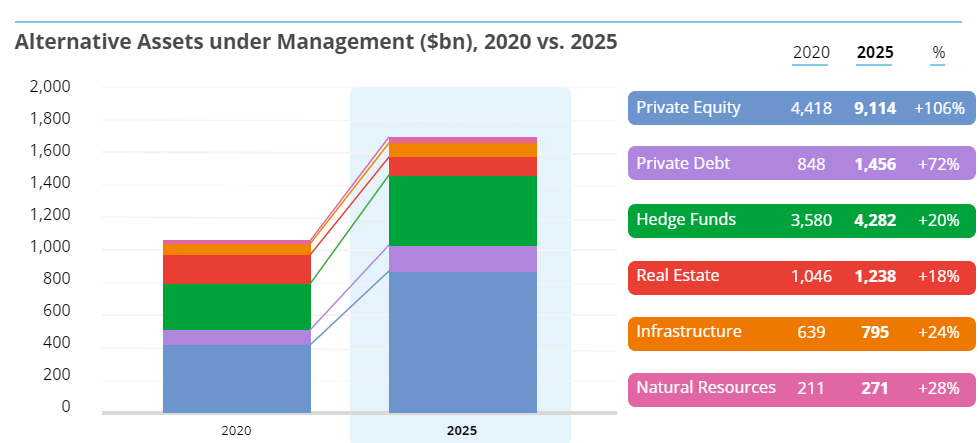There is mounting evidence to suggest that Asia Pacific’s alternative investment market is set for robust growth over the next few years.
This can be seen by the quickening pace of investor interest. In late 2020, for instance, Preqin had forecast that the region would drive the expanded interest in alternative assets globally – with assets under management (AUM) in Asia Pacific set to increase from $1.62trn to $4.97trn by 2025, according to the data provider. By mid-2021, Preqin research was showing private capital AUM on a path to hit $6tn by 2025.
Whatever the figure might be, the sentiment is based on regionally-focused private capital AUM expanding almost six-fold over the past decade, with $133bn raised during 2020 alone.
At the same time, real assets such as farmland, timberland, and infrastructure are increasingly on investors’ radars as these assets have historically performed well in a higher inflation environment like today.
“Navigating private market assets is complex. However, HNWIs in this region are gradually seeing the potential benefits, such as diversifying, enhancing returns and managing the inflationary environment,” said Henry Chui, managing director and head of private wealth for Nuveen in Asia Pacific.

Source: Preqin, as at 2020. 2025 data are forecasts
More prominent in HNWI allocations
The search for yield has dampened appetite for traditional debt while alternative income strategies, like real assets and private credit, will typically have an illiquidity premium above traditional markets.
“Instead of the previous tactical allocations to alternatives in the single digits, there has been a change in investor sentiment as they gain better understanding of these assets and how they can derive incremental yield compared with traditional fixed income,” said Chui. “The diversified source of return is a key factor versus the public markets.”
The significant potential for private credit can be seen from a study by Private Credit Fund Intelligence in conjunction with the Alternative Investment Management Association’s Alternative Credit Council (ACC).
In this “Investor Intentions H2 2021” research, 35% of respondents in the ‘private wealth’ category said they would increase private credit allocations in the six months to the end of this year,. These investors are also likely to be opportunistic in their approach, they said, with 25% eyeing separately managed accounts and 50% looking to co-invest.
At the same time, the same research showed HNWIs are adopting a more institutional-style framework to assessing and managing private credit exposure. To highlight this, two-fifths of respondents in the ‘private wealth’ category said their main reason for investing in private credit is to reach target allocation.
The appeal has grown as investors have witnessed private credit behaving “as advertised” in 2021. “This has fostered confidence around the durability, low price volatility and predictive income streams of the asset class – and, in particular, middle market loans during downturns,” explained Chui.
The tailwinds will likely continue for several reasons. For example, as pent-up demand drives the economy in the near term, consumers are expected to show the will and means to demand more products and services. There is also a large supply of middle market companies poised for growth; in the US, 200,000 firms are generating $6trn in revenues per year and employing 48 million people. In conjunction with record levels of private equity dry powder, the supply/demand story looks favourable.
In line with this, growth industries in the US such as healthcare services, software, business services and logistics, for instance, offer promising private debt and lending opportunities.
Investing in resilient ways
For real assets, meanwhile, not only will they generally provide a steady income stream, but the real benefit for portfolios is also the ability of these investments to perform well in an inflationary environment, said Chui.
Farmland and agriculture are good examples of this. Among their unique underlying characteristics is the robust demand for food driven by structural needs within societies plus expected population growth in the coming decades.
Farmland assets already proved to be predictably resilient amid the disruption in 2020 – especially in terms of income generation – with related indexes from the US to Australia delivering positive returns.
Technology is also a key dynamic in enabling farmland and agriculture to retain productivity. In turn, this fuels the potential for strong, reliable income streams as well as land appreciation.
The right managers matter
Navigating these types of less-trodden asset paths in sync with unexpected cycles demands professional and active management as the dispersion between manager performance is high. Ultimately, as investors increasingly focus on private markets, performance will depend on choosing external managers wisely.
“Unlike public markets where all securities are readily tradeable, success in private markets comes down to sourcing and underwriting,” explained Chui.
Specifically, having the “boots on the ground” along with engrained relationships means a good manager will be able to see a wide variety of deal flow, he added.
“Further, an experienced team of professionals will be able to delve into the weeds of structuring covenants that protect the investor while properly incentivising the management teams in the case of private credit.”
Click here to learn more about what Nuveen offers in real assets and private capital, as well as across other alternative investments.
*********************
The views and opinions expressed are for informational and educational purposes only as of the date of production/writing and may change without notice at any time based on numerous factors, such as market or other conditions, legal and regulatory developments, additional risks and uncertainties and may not come to pass. This material may contain “forward-looking” information that is not purely historical in nature. Such information may include, among other things, projections, forecasts, estimates of market returns, and proposed or expected portfolio composition. Any changes to assumptions that may have been made in preparing this material could have a material impact on the information presented herein by way of example. Past performance is no guarantee of future results. Investing involves risk; principal loss is possible.
All information has been obtained from sources believed to be reliable, but its accuracy is not guaranteed. There is no representation or warranty as to the current accuracy, reliability or completeness of, nor liability for, decisions based on such information and it should not be relied on as such.
GAR-1915398PR-O1121X


















